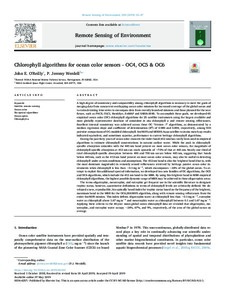Chlorophyll algorithms for ocean color sensors - OC4, OC5 & OC6.

View/
Average rating
votes
Date
2019Author
O'Reilly, John E.
Werdell, P. Jeremy
Metadata
Show full item recordAbstract
A high degree of consistency and comparability among chlorophyll algorithms is necessary to meet the goals of
merging data from concurrent overlapping ocean color missions for increased coverage of the global ocean and
to extend existing time series to encompass data from recently launched missions and those planned for the near
future, such as PACE, OLCI, HawkEye, EnMAP and SABIA-MAR. To accomplish these goals, we developed 65
empirical ocean color (OC) chlorophyll algorithms for 25 satellite instruments using the largest available and
most globally representative database of coincident in situ chlorophyll a and remote sensing reflectances.
Excellent internal consistency was achieved across these OC ‘Version -7’ algorithms, as demonstrated by a
median regression slope and coefficient of determination (R2) of 0.985 and 0.859, respectively, among 903
pairwise comparisons of OC-modeled chlorophyll. SeaWiFS and MODIS-Aqua satellite-to-in situ match-up results
indicated equivalent.....
Journal
Remote Sensing of EnvironmentVolume
229Page Range
pp.32-47Document Language
enSustainable Development Goals (SDG)
14.AEssential Ocean Variables (EOV)
Ocean colourMaturity Level
TRL 8 Actual system completed and "mission qualified" through test and demonstration in an operational environment (ground or space)Best Practice Type
Manual (incl. handbook, guide, cookbook etc)DOI Original
https://doi.org/10.1016/j.rse.2019.04.021Citation
O'Reilly, J.E. and Werdell, P.J. (2019) Chlorophyll algorithms for ocean color sensors - OC4, OC5 & OC6. Remote Sensing of Environment, 229, pp.32-47. DOI: https://doi.org/10.1016/j.rse.2019.04.021.Collections
The following license files are associated with this item:
Except where otherwise noted, this item's license is described as Attribution-NonCommercial-NoDerivatives 4.0 International
 Repository of community practices in Ocean Research, Applications and Data/Information Management
Repository of community practices in Ocean Research, Applications and Data/Information Management
